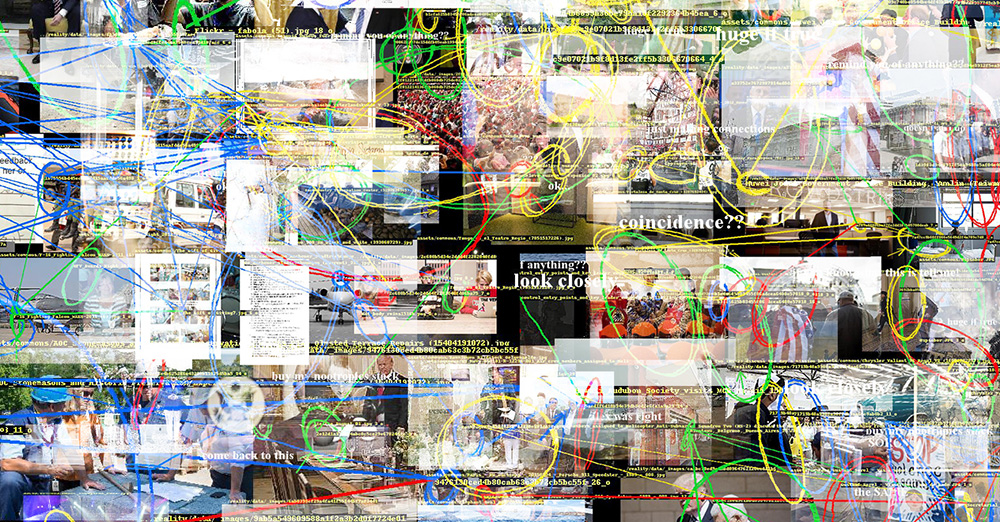It’s Time to Resurrect the Counterculture MovementThe largest progressive mobilization since the Vietnam era offers a unique opportunity.By Ira Chernus
April 17, 2017
 Women and allies fill the streets of New York City during the International Women’s Strike on March 8, 2017. (Sipa USA via AP)
Women and allies fill the streets of New York City during the International Women’s Strike on March 8, 2017. (Sipa USA via AP)You could hear the deep sadness in the preacher’s voice as he named “the greatest purveyor of violence in the world today—my own government.” With those words, the Rev. Martin Luther King Jr. delivered a scathing indictment of America’s war in Vietnam. It was April 4, 1967.
His antiwar sermon seemed to signal a new high tide of opposition to a brutal set of American policies in Southeast Asia. Just 11 days later, unexpectedly large crowds would come out in New York and San Francisco for the first truly massive antiwar rallies. Back then, a protest of at least a quarter of a million seemed “yuge.”
King signaled another turning point by concluding his speech with “something even more disturbing”—something that would deeply disturb the developing antiwar movement as well. “The war in Vietnam,” he said, “is but a symptom of a far deeper malady within the American spirit.”
Many of those who gathered at antiwar rallies days later were already beginning to suspect the same thing. Even if they could actually force their government to end its war in Vietnam, they would be healing only a symptom of a far more profound illness. With that realization came a shift in consciousness, the clearest sign of which could be found in the sizable contingent of counterculture hippies who began joining those protests. While antiwar radicals were challenging the unjust political and military policies of their government, the counterculturists were focused on something bigger: trying to revolutionize the whole fabric of American society.
Why recall this history exactly 50 years later, in the age of Donald Trump? Curiously enough, King offered at least a partial answer to that question in his 1967 warning about the deeper malady. “If we ignore this sobering reality,” he said, “we will find ourselves…marching… and attending rallies without end.” The alternative? “We as a nation must undergo a radical revolution of values.”
Like many of my generation, I feel as if, in lieu of that radical revolution, I have indeed been marching and attending rallies for the last half-century, even if there were also long fallow periods of inactivity. (In those quiet times, of course, there was always organizing and activism going on behind the scenes, preparing for the next wave of marches and demonstrations in response to the next set of obvious outrages.)
If the arc of history bends toward justice, as King claimed, it’s been a strange journey, a bizarre twisting and turning as if we were all on some crazed roller-coaster ride.
The Trump era already seems like the most bizarre twist of all, leaving us little choice but to march and rally at a quickening pace for years to come. A radical revolution in values? Unless you’re thinking of Trump’s plutocrats and environment wreckers, not so much. If anything, the nation once again finds itself facing an exaggerated symptom of a far deeper malady. Perhaps one day, like the antiwar protesters of 1967, anti-Trump protesters will say: If the American system we live under can create this atrocity, there must be something wrong with the whole thing.
But that’s the future. At present, the resistance movement, though as unexpectedly large as the movement of 1967, is still focused mainly on symptoms, the expanding list of inhumane 1 percent policies the Republicans (themselves in chaos) are preparing to foist on the nation. Yet to come up are the crucial questions: What’s wrong with our system? How could it produce a President Trump, a Republican hegemony, and the society-wrecking policies that go with them both? What would a radically new direction mean and how would we head there?
In 1967, antiwar activists were groping their way toward answers to similar questions. At least we have one advantage. We can look back at their answers and use them to help make sense of our own situation. As it happens, theirs are still depressingly relevant because the systemic malady that produced the Vietnam War is a close cousin to the one that has now given us President Trump.
Diagnosing Our Deep SicknessThe ’60s spawned many analyses of the ills of the American system. The ones that marked that era as revolutionary concluded that the heart of the problem was a distinctive mode of consciousness—a way of seeing, experiencing, interpreting, and being in the world. Political and cultural radicals converged, as the historian Todd Gitlin has observed, in their demand for a transformation of “national if not global (or cosmic) consciousness.”
Nor was such a system uniquely American, they discovered. It was nothing less than the hallmark of Western modernity.
In exploring the nature of that “far deeper malady,” Martin Luther King, for instance, turned to the European philosopher Martin Buber, who found the root of that consciousness in modernity’s “I-It” attitude. From early childhood, he suggested, we learn to see other people as mere objects (“its”) with no inherent relation to us. In the process, we easily lose sight of their full humanity. That, in turn, allows us free rein to manipulate others (or as in Vietnam simply destroy them) for our own imagined benefit.
King particularly decried such dehumanization as it played itself out in American racism: “Segregation substitutes an ‘I-it’ relationship for the ‘I-thou’ relationship and ends up relegating persons to the status of things.” But he condemned it no less strongly in the economic sphere, where it affected people of all races. “The profit motive, when it is the sole basis of an economic system,” he said, “encourages a cutthroat competition and selfish ambition that inspire men to be more I-centered than thou-centered…. Capitalism fails to realize that life is social.”
Another influential thinker of that era was a German-American philosopher, Herbert Marcuse. (Some radicals even marched in rallies carrying signs reading “Marx, Mao, Marcuse.”) For him, the dehumanization of modernity was rooted in the way science and technology led us to view nature as a mere collection of “things” having no inherent relation to us—things to be analyzed, controlled, and, if necessary, destroyed for our own benefit.
Capitalists use technology, he explained, to build machines that take charge both of the workers who run them and of aspects of the natural world. The capitalists then treat those workers as so many things, not people. And the same hierarchy—boss up here, bossed down there—shows up at every level of society, from the nuclear family to the international family of nations (with its nuclear arsenals). In a society riddled with structures of domination, it was no accident that the US was pouring so much lethal effort into devastating Vietnam.
As Marcuse saw it, however, the worst trick those bosses play on us is to manipulate our consciousness, to seduce us into thinking that the whole system makes sense and is for our own good. When those machines are cranking out products that make workers’ lives more comfortable, most of them are willing to embrace and perpetuate a system that treats them as dominated objects.
Marcuse would not have been surprised to see so many workers voting for Donald Trump, a candidate who built his campaign on promises of ever more intensified domination—of marginalized people at home, of “bad hombres” needing to be destroyed abroad, and, of course, of nature itself, especially in the form of fossil fuels on a planet where the very processes he championed ensured a future of utter devastation.
One explanation for the electoral success of Trump was the way he appealed to heartland white working-class voters who saw their standard of living and sense of social status steadily eroding. Living in a world in which hierarchy and domination are taken for granted, it’s hardly surprising that many of them took it for granted as well that the only choice available was either to be a dominator or to be dominated. Vote for me, the billionaire businessman (famed for the phrase “You’re fired!”) implicitly promised and you, too, will be one of the dominators. Vote against me and you’re doomed to remain among the dominated. Like so many other tricks of the system, this one defied reality but worked anyway.
Many Trump voters who bought into the system will find themselves facing even harsher domination by the 1 percent. And as the Trumpian fantasy of man dominating nature triggers inevitable 21st-century blowback on a planetary scale, count on growing environmental and social disasters to bring disproportionate pain to those already suffering most under the present system. In every arena, as Marcuse explained back in the 1960s, the system of hierarchy and domination remains self-perpetuating and self-escalating.
“The Long and Bitter But Beautiful Struggle for a New World”What’s the remedy for this malady, now as lethally obvious at home as it once was in Vietnam?
“The end of domination [is] the only truly revolutionary exigency,” Marcuse wrote. True freedom, he thought, means freeing humanity from the hierarchical system that locks us into the daily struggle to earn a living by selling our labor. Freedom means liberating our consciousness to search for our own goals and being able to pursue them freely. In Martin Luther King’s words, freedom is “the opportunity to fulfill my total capacity untrammeled by any artificial barrier.”
How to put an end not only to America’s war in Vietnam, but to a whole culture built on domination? King’s answer on that April 4th was deceptively simple: “Love is somehow the key that unlocks the door…. The first hope in our inventory must be the hope that love is going to have the last word.”
The simplicity in that statement was deceptive because “love” is itself such a complicated word. King often explained that the Greeks had three words for love: eros (“aesthetic or romantic love”), philia (“friendship”), and agape (“self-sacrificing devotion to others”). He left no doubt that he considered agape far superior to the other two.
The emerging counterculture of those years certainly agreed with him on the centrality of love to human liberation. After all, it was “the love generation.” But its mantra—“If it feels good, do it”—made King’s rejection of eros in the name of self-negating agape a non-starter for them.
King, however, offered another view of love, which was far more congenial to the counterculture. Love unites whatever is separated, he preached. This is the kind of love that God uses in his work. We, in turn, are always called upon to imitate God and so to transform our society into what King called a “beloved community.”
Though few people at the time made the connection, King’s Christian understanding of love was strikingly similar to Marcuse’s secular view of erotic love. Marcuse saw eros as the fulfillment of desire. He also saw it as anything but selfish, since it flows from what Freud called the id, which always wants to abolish ego boundaries and recover that sense of oneness with everything we all had as infants.
When we experience anyone or anything erotically, we feel that we are inherently interconnected, “tied together in a single garment of destiny,” as King so eloquently put it. When boundaries and separation dissolve, there can be no question of hierarchy or domination.
Every moment that hints at such unification brings us pleasure. In a revolutionary society that eschews structures of domination for the ideal of unification, all policies are geared toward creating more moments of unity and pleasure.
Think of this as the deep-thought revolution of the ’60s: Radically transformed minds would create a radically transformed society. Revolutionaries of that time were, in fact, trying to wage the very utopian struggle that King summoned all Americans to in his April 4 speech: “the long and bitter but beautiful struggle for a new world.”
50 Years Later: The Thread That BindsAt this very moment 50 years ago, a movement resisting a brutal war of domination in a distant land was giving birth to a movement calling for the creation of a new consciousness to heal our ailing society. Will the resistance movement of 2017 head in a similar direction?
At first glance, it seems unlikely. After all, ever since the Vietnam War ended, progressives have had a tendency to focus on single issues of injustice or laundry lists of problems. They have rarely imagined the American system as anything more than a collection of wrong-headed policies and wrong-hearted politicians. In addition, after years of resisting the right wing as it won victory after victory, and of watching the Democrats morph into a neoliberal crew and then into a failing party with its own dreary laundry lists of issues and personalities, the capacity to hope for fundamental change may have gone the way of Herbert Marcuse and Martin Luther King.
Still, for those looking hard, a thread of hope exists. Today’s marches, rallies, and town halls are packed with veterans of the ’60s who can remember, if we try, what it felt like to believe we were fighting not only to stop a war but to start a revolution in consciousness. No question about it, we made plenty of mistakes back then. Now, with so much more experience (however grim) in our memory banks, perhaps we might develop more flexible strategies and a certain faith in taking a more patient, long-term approach to organizing for change.
Don’t forget as well that, whatever our failings and the failings of other past movements, we also have a deep foundation of victories (along with defeats) to build on. No, there was no full-scale revolution in our society—no surprise there. But in so many facets of our world, advances happened nonetheless. Think of how, in those 50 years just past, views on diversity, social equality, the environment, health care, and so many other issues, which once existed only on the fringes of our world, have become thoroughly mainstream. Taken as a whole, they represent a partial but still profound and significant set of changes in American consciousness.
Of course, the ’60s not only can’t be resurrected, but shouldn’t be. (After all, it should never be forgotten that what they led to wasn’t a dreamed of new society but the “Reagan revolution”—as the arc of justice took the first of its many grim twists and turns.) At best, the ’60s critique of the system would have to be updated to include many new developments.
Even the methods of those ’60s radicals would need major revisions given that our world, especially of communication, now relies so heavily on blindingly fast changes in technology. But every time we log on to the Internet and browse the web, it should remind us that—shades of the past—across this embattled Earth of ours, we’re all tied together in a single worldwide web of relations and of destiny. It’s either going to be one for all and all for one, or it’s going to be none for 7.4 billion on a planet heading for hell.
Today is different, too, because our movement was not born out of protest against an odious policy, but against an odious mindset embodied in a deplorable person who nonetheless managed to take the Oval Office. He’s so obviously a symptom of something larger and deeper that perhaps the protesters of this generation will grasp more quickly than the radicals of the Vietnam era that America’s underlying disease is a destructive mode of consciousness (and not just a bad combover).
The move from resisting individual policies to transforming American consciousness may already have begun in small ways. After all, “love trumps hate” has become the most common slogan of the progressive movement. And the word “love” is being heard in hard-edged political discourse, not only on the left but among mainstream political voices like Van Jones and Cory Booker. Once again, there is even talk of “revolutionary love.”
Of course, the specific policies of the Republicans and this president (including his developing war policies) must be resisted and the bleeding of the immediate moment staunched. Yet the urgent question of the late 1960s remains: What can be done when there are so many fronts on which to struggle and the entire system demands constant vigilant attention? In the age of a president who regularly sucks all the air out of the room, how do we even talk about all of this without being overwhelmed?
In many ways, the current wave of regressive change and increasing chaos in Washington should be treated as a caricature of the system that we all have been living under for so long. Turn to that broader dimension and the quest for a new consciousness may prove the thread that, though hardly noticed, already ties together the many facets of the developing resistance movement.
The largest mobilization for progressive politics since the Vietnam era offers a unique opportunity to go beyond simply treating symptoms to start offering cures for the underlying illness. If this opportunity is missed, versions of the same symptoms are likely to recur, while unpredictable new ones will undoubtedly emerge for the next 50 years, and, as Martin Luther King predicted, we will go on marching without end. Surely we deserve a better future and a better fate.
Ira Chernus Ira Chernus is a professor of religious studies at the University of Colorado at Boulder and author of Apocalypse Management: Eisenhower and the Discourse of National Insecurity. Read more of his writing on Israel, Palestine and American Jews on his blog.
https://www.thenation.com/article/its-t ... -movement/










